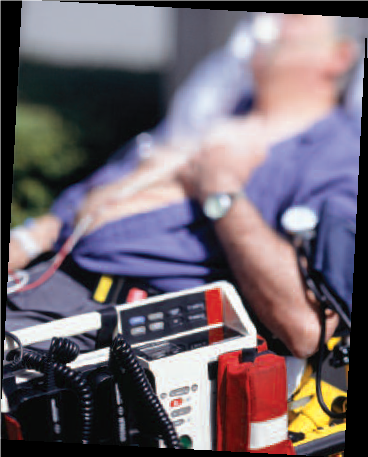News, views and insights on maintaining a healthy edge.
 Don’t Walk Sign Are you a sleepwalker? If so, you’re definitely not alone. New research by the Stanford University School of Medicine found that somnambulism is far more prevalent than previous studies suggested. About 3.6 percent of American adults are prone to nocturnal wandering. That translates to 8.4 million. The same research suggests that sleepwalking is linked to anxiety and depression. A subject of humor and silliness in popular culture, this disorder can actually have serious consequences. Sleepwalkers have been known to injure themselves and others. They are also prone to psychosocial disorders. The Trinitas Sleep Disorders Center deals with sleepwalking and other problems every day. For information call 908-994-8694.
Don’t Walk Sign Are you a sleepwalker? If so, you’re definitely not alone. New research by the Stanford University School of Medicine found that somnambulism is far more prevalent than previous studies suggested. About 3.6 percent of American adults are prone to nocturnal wandering. That translates to 8.4 million. The same research suggests that sleepwalking is linked to anxiety and depression. A subject of humor and silliness in popular culture, this disorder can actually have serious consequences. Sleepwalkers have been known to injure themselves and others. They are also prone to psychosocial disorders. The Trinitas Sleep Disorders Center deals with sleepwalking and other problems every day. For information call 908-994-8694.
Oh, Canada The never-ending legal debate over medical marijuana acquired an intriguing new wrinkle in May after a report in the Canadian Medical Association Journal on the results of a new study on patients with Multiple Sclerosis. A group of MS sufferers with muscle spasticity (hard-to-control muscles) who had not responded well to traditional treatment showed a 30% reduction in spasticity and a 50% reduction in pain after smoking marijuana over a threeday period. The side effects were hardly a surprise. Patients showed a drop in cognitive ability and experienced some dizziness and nausea. A few reported feeling “too high.” The study only looked at short-term effects on the MS patients, but results were encouraging enough to warrant more extensive research.

New Options for Hospice Care One of the greatest concerns in hospices is preventing sudden and deep depression. Standard antidepressant medications are only marginally successful in this setting, as they take time to achieve their desired effect—and time is something hospice patients don’t have. That explains the buzz at the recent annual meeting of the American Academy of Hospice and Palliative Medicine when it was reported that methylphenidate and oral ketamine are showing considerable promise as extremely rapid-acting, safe, and cost-effective treatments. Ketamine in particular is a drug already used in hospices to deal with pain. According to Dr. Scott Irwin, director of psychiatry programs at the Institute for Palliative Medicine at San Diego Hospice, more research is needed. Clinical trials are problematic in hospices because of the high death rate, as well as informed consent issues. 
Answering the Call A college student who lives in New Jersey has filed a patent for a smaller, less invasive implantable cardioverter defibrillator—the battery powered device used to prevent sudden cardiac arrests in people who suffer from arrhythmia. Benjamin Strauss, a volunteer ambulance crew chief, came up with the idea after two calls to the same patient in Bergenfield in a span of two months. A biomedical engineering major at Cooper Union in New York, Strauss delivered the student commencement address this past May. The one-inch square defibrillator, which he dubbed iRescue, was created as his senior project. “I wanted to do something that would enable me, at some point, to actually contribute to making people’s lives better,” Strauss explains. “And I didn’t find anything that made this kind of treatment less invasive.”
 Another Link Between TV & Obesity From the “Wait, Didn’t We Know that Already?” department comes the news that kids who watch a lot of TV have poorer overall diets than kids whose exposure to television is limited. “The more TV you watch, the less likely you were to eat fruits and vegetables every day, and the more likely you were to eat things like candy and soda, eat at a fast-food restaurant and even skip breakfast,” says study author Leah Lipsky of the Eunice Kennedy Shriver National Institute of Child Health and Human Development. The research doesn’t prove that TV watching influences what kids eat, but strongly suggests a link between TV, snacking and a lack of exercise. Add questionable parenting to the mix and you have yet another contributing factor to America’s epidemic of childhood obesity. The average age of the children in the study was 13.
Another Link Between TV & Obesity From the “Wait, Didn’t We Know that Already?” department comes the news that kids who watch a lot of TV have poorer overall diets than kids whose exposure to television is limited. “The more TV you watch, the less likely you were to eat fruits and vegetables every day, and the more likely you were to eat things like candy and soda, eat at a fast-food restaurant and even skip breakfast,” says study author Leah Lipsky of the Eunice Kennedy Shriver National Institute of Child Health and Human Development. The research doesn’t prove that TV watching influences what kids eat, but strongly suggests a link between TV, snacking and a lack of exercise. Add questionable parenting to the mix and you have yet another contributing factor to America’s epidemic of childhood obesity. The average age of the children in the study was 13.





